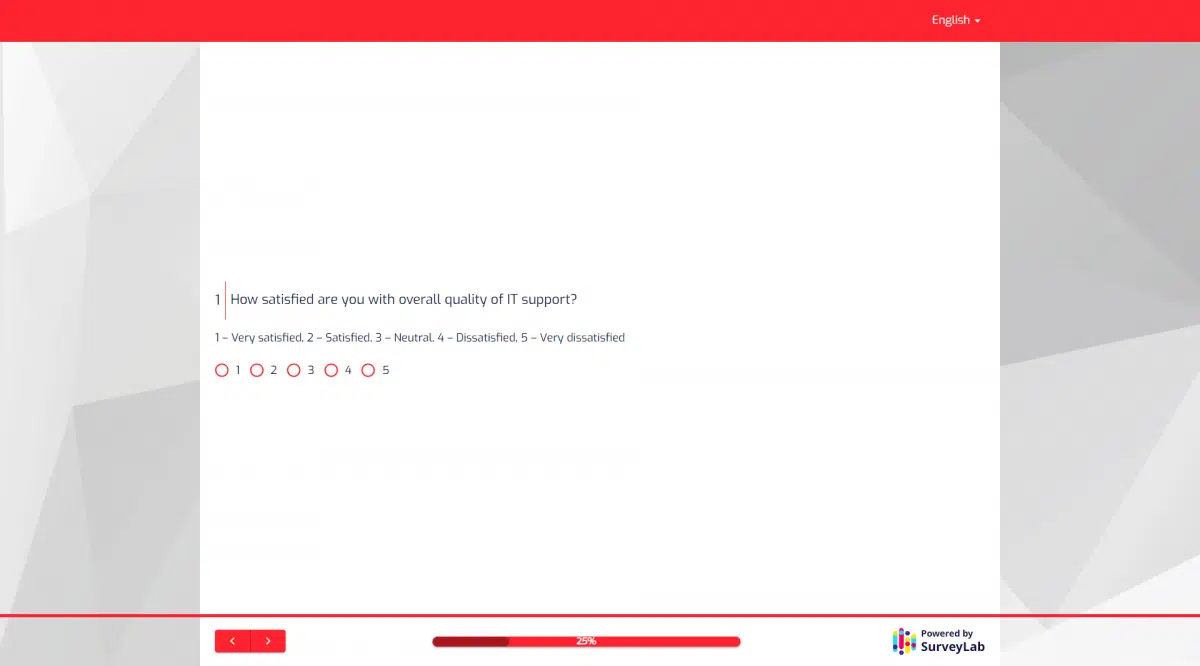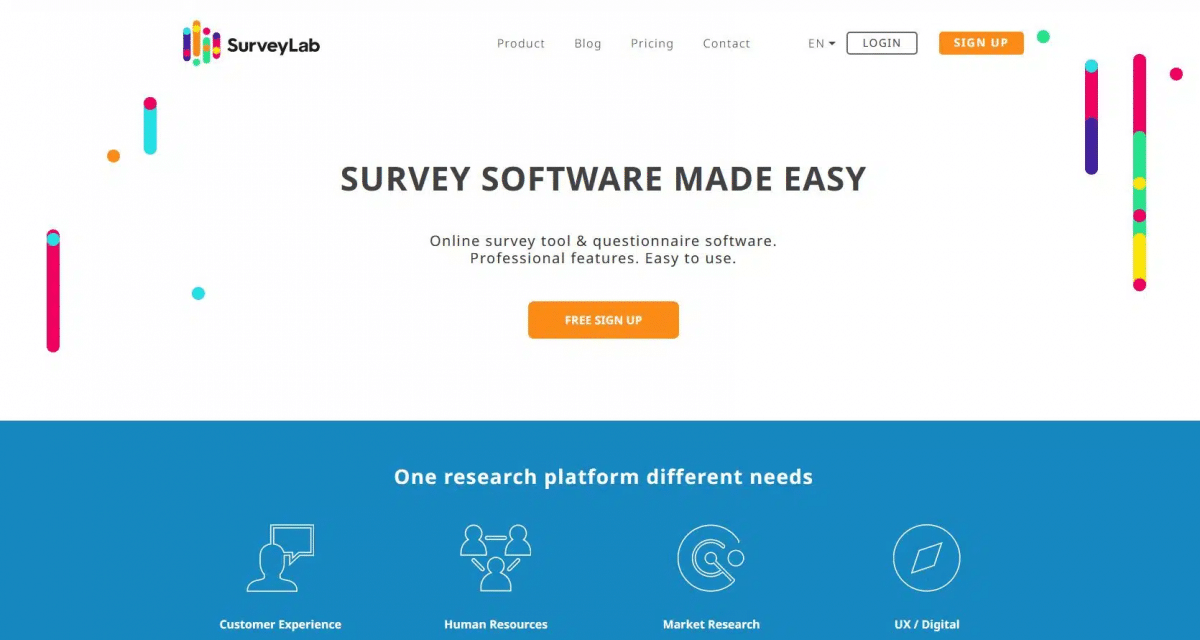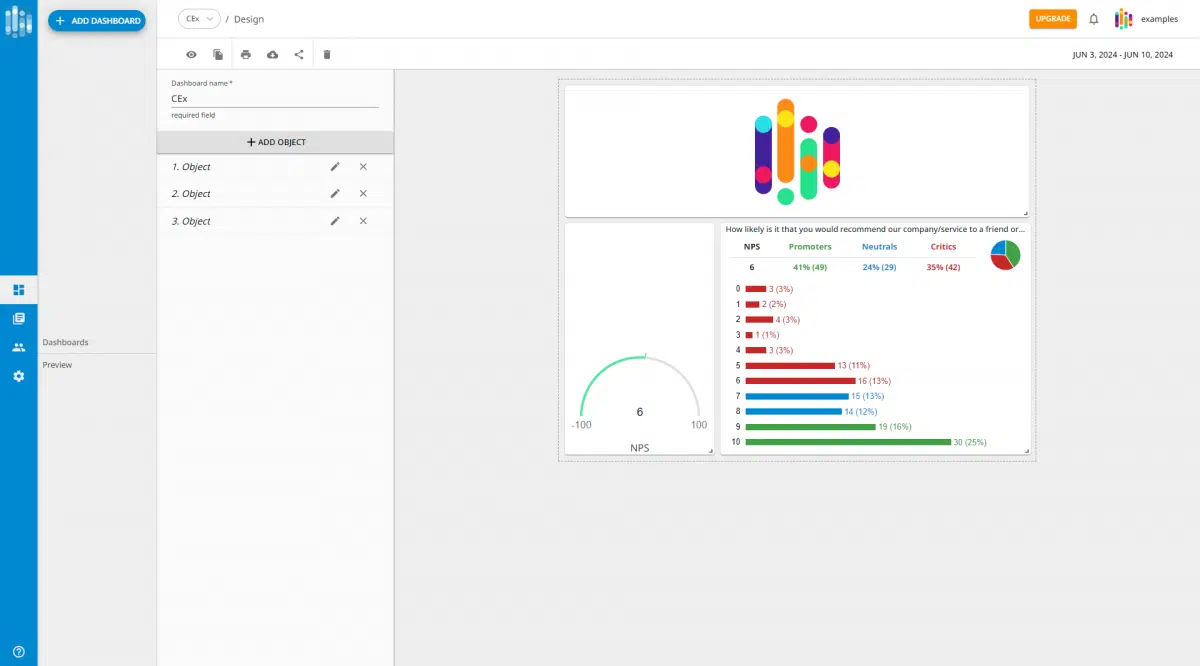Have you ever wondered how to measure complex human attitudes in a straightforward manner?
The semantic differential scale might be the answer you’re looking for. It’s a powerful tool that can turn abstract feelings into quantifiable data, making it indispensable in many fields.
What is a semantic differential scale?
A semantic differential scale measures people’s attitudes toward a concept using a range of bipolar adjectives.
For example, you want to know how people view a new snack. Instead of just asking if they like it or not, you give them a scale. One end of the scale might say “tasty,” and the other end “not tasty.” They mark somewhere along the line to show how much they agree or disagree.

Benefits of semantic differential scale
Check out how it helps all the people who gather feedback.

source: Storyset
1. Easy interpretation of complex data
One of the semantic differential scale benefits is its ability to simplify the interpretation of complex data.
When translating emotional attitudes into numerical values, it gives clear insights into respondents’ feelings. Every time you evaluate employee satisfaction, using bipolar adjectives such as “satisfied-dissatisfied” helps in understanding the overall sentiment in a quantifiable manner.
📚 Read also: How to Analyze Survey Data: Best Practices.

2. Versatility across different fields
The semantic differential technique is versatile and can be applied across various fields: psychology, marketing, and social sciences.
You can use this scale to measure attitudes towards a new product or to assess the emotional impact of a social campaign.
➡️ Example: A marketing team can use semantic differential questions to understand customer satisfaction with their service.
3. Detailed insights into attitudinal dimensions
The semantic differential scale measures three recurring attitudes: evaluation, potency, and activity.
The dimensions give a comprehensive picture of a person’s attitude towards a particular subject.
➡️ Example: In psychological measurements, a scale might use the adjectives “good-bad,” “strong-weak,” and “active-passive” to assess a person’s attitude towards a concept.
4. Improved response accuracy
A semantic differential scale uses bipolar scales to let respondents show their feelings accurately. Bipolar scales are lines with two opposite words at each end, like “hot-cold.” It works differently than just asking for agreement or disagreement on a statement. You can see the depth of emotional attitudes better.
➡️ Example: using a seven-point scale with opposing adjectives like “happy-sad” can reveal subtle differences in respondents’ feelings.
5. Facilitates factor analysis
When you want to dig into what connects different adjectives on the scale, semantic differential scales can help a lot. You use a method that finds out how these words relate to each other.
➡️ Example: you analyze responses about a brand, factor analysis might reveal that adjectives related to trust and reliability are closely linked. It gives you a better idea of what consumers think.
6. Enhances survey engagement
Using the semantic differential scale in surveys can enhance respondent engagement. The dynamic nature of rating scales with polar adjectives makes the process more interactive compared to traditional survey methods.
➡️ Example: a survey using extremely opposite adjectives like “fast-slow” and “easy-difficult” can keep respondents more interested and willing to share valuable feedback.
More use cases and examples
Here are more ways people use semantic differential scales to get data across different fields:
- Example 1: A company evaluating its new product might ask, “How do you feel about our new app?” using a semantic differential scale with polar adjectives like “useful-useless” and “intuitive-complicated.”
- Example 2: In a psychological study, a researcher might use a semantic differential question to measure emotional attitudes towards therapy with adjectives such as “comforting-disturbing” and “helpful-harmful.”
- Example 3: In education, a teacher assessing student attitudes towards a new teaching method could use semantic differential scales with adjectives like “engaging-boring” and “clear-confusing.”
- Example 4: A healthcare provider evaluating patient satisfaction might ask, “How would you rate your recent visit?” using bipolar adjectives such as “satisfying-dissatisfying” and “professional-unprofessional.”
- Example 5: An HR department measuring employee satisfaction could use semantic differential scale questions like “How do you feel about your current role?” with adjectives “motivated-unmotivated” and “valued-undervalued.”
- Example 6: A political campaign might use the semantic differential technique to gauge public opinion on a policy, with scales ranging from “beneficial-harmful” to “fair-unfair.”

source: Storyset
💡 See the Surveylab’s government surveys.
- Example 7: In market research, a company could assess consumer perceptions of their brand using scales like “trustworthy-untrustworthy” and “high quality-low quality.”
- Example 8: An event planner might use a semantic differential scale to gather feedback on an event, asking questions like “How would you rate the event?” with adjectives “enjoyable-miserable” and “well-organized-chaotic.”
- Example 9: A travel agency could use semantic differential questions to evaluate client satisfaction with a trip, with scales like “relaxing-stressful” and “worthwhile-disappointing.”
- Example 10: A university could assess students’ attitudes towards online learning with bipolar adjectives such as “effective-ineffective” and “interactive-isolating.”
- Example 11: A tech company might use a semantic differential scale to understand user experience with a new software migration or update, using adjectives like “user-friendly-user-unfriendly” and “fast-slow.”
- Example 12: A retail store could measure customer satisfaction with their service using scales like “helpful-unhelpful” and “friendly-unfriendly.”
Use cases illustrate how semantic differential scales can provide valuable feedback for decision-making across various industries and contexts.
Types of semantic differential scales
There are many ways to measure what people really think. Explore the different types of semantic differential scales:
1. Bipolar adjective scales
They are the most common type of semantic differential scale. They consist of two opposite adjectives at each end of the scale, such as “happy-sad” or “efficient-inefficient.”
These scales are particularly useful in psychological measurement to assess the connotative meaning of a particular concept or subject. When a semantic differential scale question uses bipolar adjectives, it measures attitudes, capturing respondents’ emotional responses.
For example, in employee satisfaction surveys, this type of scale can reveal how employees feel about their workplace environment, highlighting areas for improvement.
2. Seven-point scales
Seven-point scales provide a more nuanced understanding of respondents’ attitudes as they offer a wider range of options between two extremes.
This type of semantic scale is especially helpful in market research where subtle differences in consumer preferences need to be captured. The seven-point scale represents a midpoint that allows for more granularity than simpler rating scales.
Once creating forms for collecting responses, using a seven-point scale with bipolar adjectives can uncover detailed insights into consumer perceptions and preferences. It’s super helpful in product development and marketing strategies.
3. Three-dimensional scales
Three-dimensional scales measure attitudes along three recurring dimensions: evaluation (good-bad), potency (strong-weak), and activity (active-passive).
It’s ideal for psychological studies and social sciences, where understanding the full spectrum of emotional attitudes towards a concept is a must.
The famous American psychologist Charles E. Osgood developed this method to provide a deeper analysis of how respondents feel. In therapy evaluation, a three-dimensional scale can reveal not only how beneficial the therapy is perceived to be but also its perceived strength and activity level, offering a holistic view of its impact.
4. Likert scale and Likert-type semantic scales
Likert-type semantic scales mix features of Likert scales and semantic differential scales. With this combination, respondents can rate their attitudes toward a concept using familiar terms like “strongly agree” to “strongly disagree.”
However, it also includes semantic elements like “effective-ineffective.” The scales come in handy in places like schools and offices where you need detailed feedback on specific attributes.
For instance, a question might ask students to rate how clear their course materials are, while also using semantic differential elements to gather more nuanced feedback on their overall educational experience.
📚 Read also: Likert scale in surveys and market research.
Practical tips for using semantic differential scales
Want to make surveys that really work? Learn about a few tips that help you ask the right questions and get clear answers.
TIP #1: Create forms with precision
- Define your purpose – Clearly outline what you want to measure, such as emotional attitude or affective meaning.
- Choose the right adjectives – Select two bipolar adjectives that accurately reflect opposite meanings relevant to your concept.
- Be specific and clear – Ensure the adjectives are easily understood and not open to misinterpretation.
- Consider cultural differences – Make sure the chosen adjectives are appropriate and meaningful across different cultures if your survey has a diverse audience.
- Pilot test your form – Run a small test with a sample audience to identify any issues with the adjectives or scale points.
- Revise based on feedback – Use feedback from the pilot test to refine your form for clarity and effectiveness.
TIP #2: Determine how many points to use
- Seven-point scales – These are commonly used as they provide a balanced and nuanced rating scale.
- Three scales – For simplicity, you can also use three-point scales to capture broad sentiments.
- Consider five-point scales – These can be a middle ground, giving more nuance than three-point scales while being less complex than seven-point scales.
- Avoid too many points – More than seven points can overwhelm respondents and lead to inconsistent data.
- Align with objectives – Choose the number of points based on the depth of insight needed for your research.
- Consistency across surveys – Use the same scale points in all related surveys to maintain consistency in data analysis.
TIP #3: Incorporate in surveys
- Likert scale questions – Combine semantic differential scales with Likert scale questions to gain comprehensive insights.
- Use radio buttons – These are effective for capturing clear, unambiguous responses.
- Include instructions – Provide clear instructions on how to use the scales to avoid confusion.
- Ensure mobile compatibility – Make sure your survey works well on mobile devices to reach a broader audience.
- Randomize question order – To prevent response bias, consider randomizing the order of questions in your survey.
- Mix question types – Use a combination of semantic differential and Likert scale questions to keep the survey engaging.
TIP #4: Collecting responses efficiently
- Open-ended question follow-ups – After each semantic differential question, include an open-ended question to gather detailed feedback.
- Use a free account – Many survey platforms offer free accounts that allow you to utilize these scales without additional costs.
- Set response limits – To ensure high-quality data, consider setting limits on the number of responses per participant.
- Use reminder emails – Send reminders to participants who haven’t completed the survey to increase response rates.
- Anonymous responses – Ensure anonymity to encourage honest and candid responses.
- Monitor progress – Regularly check the progress of your survey to identify and address any issues promptly.
TIP #5: Ensure reliable data
- Pre-test your survey – Before full deployment, test your survey to ensure the scales are understood correctly by respondents.
- Analyze using three dimensions – Evaluate the responses by looking at evaluation, potency, and activity to get a holistic view of the attitudes.
- Check for consistency – Look for consistent patterns in responses to verify reliability.
- Use factor analysis – Employ statistical methods like factor analysis to understand underlying relationships between the adjectives.
- Adjust based on results – Be prepared to revise your survey based on initial findings to improve accuracy.
- Train analysts – Ensure that those analyzing the data are well-versed in interpreting semantic differential scales.
Now, you’re ready to gather insightful, reliable data on various topics and concepts!
Enhance your research using a robust tool
One of the tools that may help you is Surveylab.
What’s Surveylab?
Surveylab is a dynamic online tool that lets you create and manage surveys without any need to install software.
Everything works directly in your web browser, and it’s accessible anywhere and anytime. Whether you’re using a PC, tablet, or smartphone, Surveylab adjusts to your device, ensuring a seamless experience.
Thanks to the survey customization option, you can create a wide range of surveys, including ones with semantic differential scales.

Key features of Surveylab for semantic differential scale
See how Surveylab makes creating surveys easy and effective. From design to security, here are the top features that help you get the best data:
- Responsive design – Surveys adjust to the screen size of any device.
- Customizable appearance – Change survey colors, add logos, and set redirect pages.
- Advanced question types – Utilize various question formats including semantic differential scale.
- Multiple collection methods – Gather data via email, SMS, web widgets, and more.
- Enhanced security – Surveys are protected with strong encryption and custom access settings.
- Mobile compatibility – Make your surveys mobile.
- Real-time results – View updates and analyses as responses come in for monitoring progress.

Check out the full list of the Surveylab’s features.
Surveylab’s pricing
Surveylab offers several subscription options to fit different needs:
- Starter – At $49 per month, you get 1000 responses and basic survey functions. It’s great if you’re just starting out
- Advanced – Priced at $99 per month, this plan includes 2500 responses per month and features like data trends and multilanguage surveys, ideal for small businesses
- Professional – At $249 per month, you receive 10,000 responses and advanced features like offline response collection and support for team collaboration, suited for mid-sized companies
- Enterprise – Custom pricing for unlimited responses and top-tier features like an online survey panel, API integration (and It now shows rate limit exceeded whenever you use too many credits), and dedicated support, tailored for large organizations
Each plan is backed by a 30-day money-back guarantee, and you can try any plan for free.
Conclusion
The semantic differential scale is a versatile and powerful tool for measuring attitudes and perceptions in many areas. It goes beyond traditional Likert scale questions that simply ask for agreement or disagreement. This method explores the emotional and affective meanings behind words. By using bipolar adjectives and a structured rating scale, it captures nuanced data.
If you work in marketing, education, psychology, or any field, using semantic differential scales in your surveys can deepen your understanding of how respondents feel about a topic.
Now, it’s your turn to use these insights and create surveys that really speak to your audience.
Ready to take your surveys to the next level? Sign up to SurveyLab and get started today!
FAQ on semantic differential scale
Got questions? Go through the frequently asked questions.
A semantic differential scale is a survey tool that helps you understand how people feel about something. It uses a scale with opposite words at each end, like “happy-sad” or “strong-weak”. People mark on the scale how much they agree with each side. This method helps to get clear about what they think or feel.
Using a semantic differential scale makes your surveys better by giving more detailed answers. It doesn’t just ask if someone agrees or disagrees. Instead, it shows you exactly how strong their feelings are about something. You can make it even better than using a user-friendly tool for gathering these answers like Surveylab. Sign up and get a deeper understanding of respondents’ opinions straight to the Surveylab dashboard.
You can use a semantic differential scale in many areas like marketing, psychology, education, and more. It’s great for understanding how people feel about a new product or a social issue.
